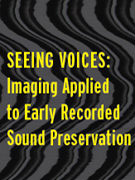
The Yale Library is delighted to offer a lecture and reception featuring Professor Carl Haber, Senior Scientist at the Lawrence Berkeley National Laboratory and 2013 MacArthur Fellow. The event is sponsored by the Richard Warren Jr. (B.A. 1959) Fund for the Preservation and Promotion of Music.
Sound was first recorded and reproduced by Thomas Edison in 1877. Until about 1950, when magnetic tape use became common, most recordings were made on mechanical media such as wax, foil, shellac, lacquer, and plastic. Some of these older recordings contain material of great historical interest, sometimes in obsolete formats, and are damaged, decaying, or are now considered too delicate to play.
Unlike print and latent imagescanning, the playback of mechanical sound carriers has been an inherently invasive process. Recently, a series of techniques, based upon non-contact optical metrology and image processing, have been applied to create and analyze high resolution digital surface profiles of these materials. Numerical methods may be used to emulate the stylus motion through such a profile in order to reconstruct the recorded sound. This approach, and current results, including studies of some of the earliest known sound recordings, are the focus of this talk and will be illustrated with sounds and images.
Carl Haber is an experimental physicist who received his Ph.D. in Physics from Columbia University and is a Senior Scientist in the Physics Division of Lawrence Berkeley National Laboratory. Read more here.